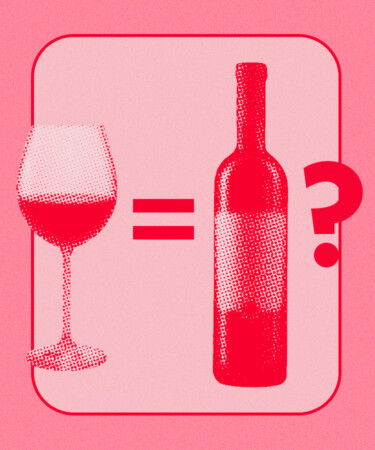
There’s a lot of misinformation when it comes to restaurant wine lists and how they’re priced. The lack of transparency around value and markups has perpetuated myths like “you should always order the second-cheapest bottle on the menu,” or “the bottle price in a restaurant is always three times higher than its retail value.” One of the most common rumors is that the listed by-the-glass price is actually what the restaurant paid for the full bottle of wine.
This concept can be discouraging for guests, especially when they’re deciding between a strong cocktail and a 5-ounce serving of Sauvignon Blanc. For those who frequently drink wine at home, paying the same amount for a glass as they would for a bottle at the shop can feel like a rip-off — but this isn’t always necessarily the case. VinePair tapped Gabriella Borg Costanzi, beverage and service director for Brooklyn French restaurant Le Crocodile and rooftop bar Bar Blondeau, to explain why you might be getting charged bottle prices for a single pour.
“The truth is, a lot of people do this,” Borg Costanzi admits. “A lot of somms are taught this way, at least in the U.S. It’s an easy way to make sure you’re making a good revenue percentage on the glass.” Although this cut-and-dry strategy might work for some establishments, Borg Costanzi takes a more dynamic approach to her beverage programs.
“As a business you need to decide what profit margin you need to make on every product to make it a viable business plan,” she says. “From there, the way I have always approached it is taking several factors into consideration.”
First, Borg Costanzi blind-tastes the wine and asks herself how much she would pay for a glass of this particular bottle. Then, she considers how stable the wine is. Can the wine maintain its freshness and quality if it’s open during an entire service, or will a percentage of the wine be wasted by opening the bottle to serve by the glass? That’s why bottles that might not last as long once opened, like a pét-nat, may be priced slightly higher than their more resilient equivalents.
Borg Costanzi also looks at the entire menu holistically when finalizing pricing. “I look at our list as a whole, and ask what’s the weighted average across the list?” she says. “If one wine makes a higher profit, one can make a lower profit.”
For example, if a restaurant can buy a popular wine like a Pinot Noir in high quantities, it might be able to get a deal — making it a high-margin sale by the glass. On the other end of the spectrum, an establishment might buy a more obscure wine, like Jacquère from France’s Savoie region, in smaller quantities. If these wines are priced similarly by the glass, the Jacquère might make lower margins, but will be balanced out by the popularity of a wine like Pinot Noir. This kind of flexibility also allows spots with extensive wine lists to offer wines by the glass at a range of prices, and even include happy-hour deals — during Le Crocodile’s Apero Time, special by-the-glass pours are offered for just $9 between 5 and 7 p.m.
Occasionally, diners will run into a $17 glass of Chardonnay that they could find at the store for a similar price. In reality, there are a lot of complicated factors that go into designing a cohesive by-the-glass list that can keep a restaurant in business. Either way, don’t let the markups deter you from enjoying your favorite wine at a restaurant. It’s likely that everything else on the menu — from the burgers to the Martinis — shares similar price hikes, and that’s just the cost of dining out.
*Image retrieved from Day Of Victory Stu. via stock.adobe.com
